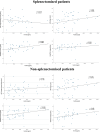Assessment of ferritin and hepcidin levels in splenectomised and non-splenectomised β-thalassemia major patients and exploring a potential correlation with von Willebrand factor and ADAMTS-13
- PMID: 40232405
- PMCID: PMC12053081
- DOI: 10.1007/s00277-025-06360-8
Assessment of ferritin and hepcidin levels in splenectomised and non-splenectomised β-thalassemia major patients and exploring a potential correlation with von Willebrand factor and ADAMTS-13
Abstract
Iron overload is a major complication in β-thalassemia major (β-TM) patients, resulting from ineffective erythropoiesis, increased gastrointestinal iron absorption and multiple blood transfusions. Excess iron accumulates in various organs, leading to organ dysfunction, and increased risk of thrombotic events. In this study we aim to determine levels of ferritin and its regulation hormone hepcidin in multi-transfused splenectomised and non-splenectomised β-thalassemia major patients and assess a possible correlation with the coagulation protein von Willebrand factor (vWF) and its cleaving protease ADAMTS-13. The study was conducted on 80 β-thalassemia major patients and 80 age- and sex-matched healthy controls. Plasma levels of vWF, ADAMTS-13, and hepcidin were assessed using the ELISA method. All patients presented with significantly higher levels of ferritin compared to normal controls (p < 0.001), while hepcidin levels were barely higher in patients (p = 0.05). Ferritin had a positive correlation with vWF antigen levels (r = 0.222, p = 0.05), ADAMTS-13 antigen levels (r = 0.334, p = 0.002) and ADAMTS-13 activity levels (r = 0.353, p = 0.001) in patients. Splenectomised patients had significantly higher levels of white blood cell counts, platelet counts and vWF antigen levels compared to non-splenectomised patients (p < 0.05), but ferritin and hepcidin levels were comparable between the two groups (p > 0.05). Hepcidin was not found to be correlated with any of the measured parameters in patients (p > 0.05). Iron overload is well manifested in our study group despite continuous chelation therapy. Unlike hepcidin, ferritin appeared to be associated with increased secretion of vWF and ADAMTS-13 in patients, while splenectomy had no effect on ferritin or hepcidin levels. These findings highlight the importance of proper iron monitoring in β-TM and recognition of thrombotic risks in managing this anemia.
Keywords: Hepcidin; Hypercoagulability; Iron overload; Splenectomy; Thalassemia.
© 2025. The Author(s).
Conflict of interest statement
Declarations. Ethical approval: The study was performed in accordance with the Declaration of Helsinki and was approved by Kuwait Ministry of Health and Kuwait University ethical committee. Informed, signed consent was obtained from all participating subjects. Competing interests: The authors declare no competing interests.
Figures


Similar articles
-
Evaluating von Willebrand factor and ADAMTS13 levels in thalassemia major patients and assessing a possible association with Thrombospondin-1.Int J Lab Hematol. 2023 Dec;45(6):945-952. doi: 10.1111/ijlh.14135. Epub 2023 Jul 12. Int J Lab Hematol. 2023. PMID: 37438087
-
Serum Hepcidin as a Diagnostic Marker of Severe Iron Overload in Beta-thalassemia Major.Indian J Pediatr. 2017 Oct;84(10):745-750. doi: 10.1007/s12098-017-2375-4. Epub 2017 Jun 10. Indian J Pediatr. 2017. PMID: 28600663
-
Iron overload across the spectrum of non-transfusion-dependent thalassaemias: role of erythropoiesis, splenectomy and transfusions.Br J Haematol. 2017 Jan;176(2):288-299. doi: 10.1111/bjh.14373. Epub 2016 Dec 5. Br J Haematol. 2017. PMID: 27917462 Free PMC article. Clinical Trial.
-
Hepcidin and Hfe in iron overload in beta-thalassemia.Ann N Y Acad Sci. 2010 Aug;1202:221-5. doi: 10.1111/j.1749-6632.2010.05595.x. Ann N Y Acad Sci. 2010. PMID: 20712796 Free PMC article. Review.
-
β-thalassemia: a model for elucidating the dynamic regulation of ineffective erythropoiesis and iron metabolism.Blood. 2011 Oct 20;118(16):4321-30. doi: 10.1182/blood-2011-03-283614. Epub 2011 Jul 18. Blood. 2011. PMID: 21768301 Free PMC article. Review.
References
-
- Origa R (2017) β-Thalassemia. Genet Sci 19(6):609–619. 10.1038/gim.2016.173
-
- Yadav PK, Singh AK (2022) A review of iron overload in Beta-Thalassemia major, and a discussion on alternative potent iron chelation targets. Plasmatology. 10.1177/26348535221103560. 26;16
-
- Koohi F, Kazemi T, Miri-Moghaddam E (2019) Cardiac complications and iron overload in beta thalassemia major patients-a systematic review and meta-analysis. Ann Hematol 98(6):1323–1331. 10.1007/s00277-019-03618-w - PubMed
-
- De Sanctis V, Soliman A, Yassin M (2013) Iron overload and glucose metabolism in subjects with β-thalassaemia major: an overview. Curr Diabetes Rev 9(4):332–341. 10.2174/1573399811309040005 - PubMed
MeSH terms
Substances
LinkOut - more resources
Full Text Sources
Miscellaneous

